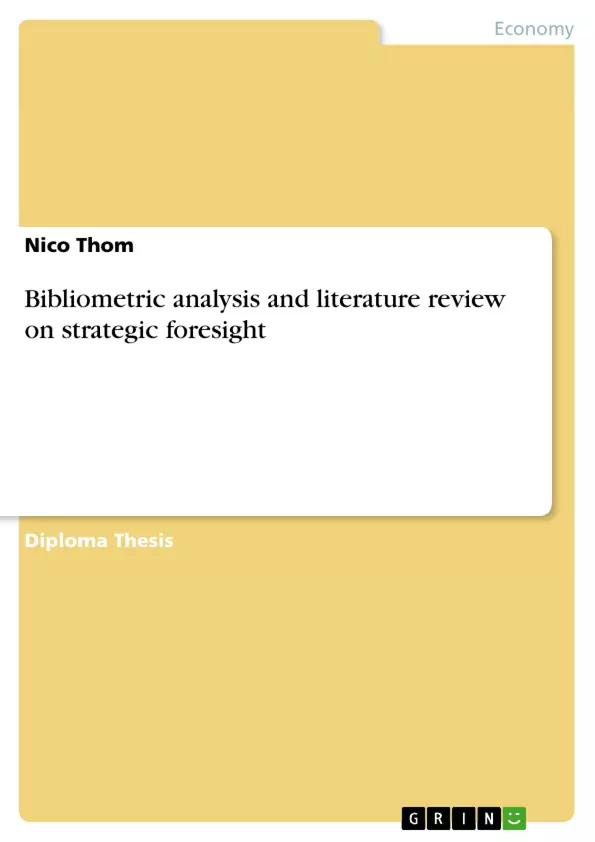Rapid changes in technology and growing competition in consumer as well as business customer markets are forcing industry to explore new ways to foster product and service innovations. Especially multinational companies need to identify developments and trends in their technical, political, competitive, and consumer environment early in order to be capable of acting. Strategic Foresight is a framework, which allows the identification of weak signals of changes and reacting to these.
This thesis identifies and analyzes the existing literature concerning Strategic Foresight by means of bibliometric analysis and literature review.
For the bibliometric analysis the Science Citation Index and additional databases of journal publishers have been selected. These databases have been searched for journal articles and conference articles related to Strategic Foresight. The identified journal articles have been categorized concerning research field, research perspective, and discussed subjects. Journal articles have been analyzed for the most active authors and for journals with the highest number of articles related to Strategic Foresight. Conference articles have been analyzed concerning conferences dealing the most with Strategic Foresight.
In result, a growing scientific activity in the field of Strategic Foresight is shown. Seven highly relevant conferences, 15 highly relevant journals, and 12 major authors in the field of Strategic Foresight have been identified. Furthermore, seven key aspects revealed, which are dealt with in literature: methods, goals, process, actors, organizational structure, elements, and value creation of Strategic Foresight. A different emphasis on each of these aspects has been noticed. While many articles are describing methods used for foresighting, only a small number of articles are discussing the value creation of Strategic Foresight. In addition, the literature review revealed research gaps in how to select appropriate methods and how to measure value creation.
Inhaltsverzeichnis (Table of Contents)
- Introduction
- Background
- Research Gap
- Research Questions
- Structure
- Methodology
- Bibliometric Analysis
- Database Selection
- Automated Search
- Manual Filtering
- Categorization
- Analysis
- Literature Review
- Results from the Bibliometric Analysis
- Sample
- Major Conferences
- Major Journals
- Major Authors
- Identified Subjects
- Results from the Literature Review
- Strategic Foresight and its Elements
- Goals of Strategic Foresight
- Organizational Structure of Strategic Foresight
- Actors involved in Strategic Foresight
- The Process of Strategic Foresight
- Methods of Strategic Foresight
- Value Creation
- Conclusion and Further Research
Zielsetzung und Themenschwerpunkte (Objectives and Key Themes)
This thesis aims to analyze existing literature on Strategic Foresight through a comprehensive bibliometric analysis and literature review. The study aims to identify and categorize key publications, conferences, and authors in the field, as well as explore the main subjects and research gaps within the literature.
- Bibliometric analysis of research publications on Strategic Foresight
- Identification of leading authors, journals, and conferences in the field
- Categorization of research topics and perspectives on Strategic Foresight
- Analysis of key elements and aspects of Strategic Foresight, including its methods, goals, process, actors, organizational structure, and value creation
- Exploration of research gaps and potential future research directions in the field
Zusammenfassung der Kapitel (Chapter Summaries)
- Introduction: This chapter provides an overview of the background and motivation for the study, outlining the research gap and the specific research questions addressed in the thesis.
- Methodology: This chapter describes the methods used for the bibliometric analysis and literature review, including the databases used, the search criteria, and the categorization and analysis techniques.
- Results from the Bibliometric Analysis: This chapter presents the findings of the bibliometric analysis, highlighting the identified major conferences, journals, authors, and subjects related to Strategic Foresight.
- Results from the Literature Review: This chapter delves into the thematic analysis of the literature, discussing the key elements and aspects of Strategic Foresight, including its goals, organizational structure, actors, processes, methods, and value creation.
Schlüsselwörter (Keywords)
The primary keywords and focus topics of this thesis include Strategic Foresight, bibliometric analysis, literature review, methodology, research gaps, key elements, methods, goals, process, actors, organizational structure, value creation, and research directions.
- Citation du texte
- Nico Thom (Auteur), 2007, Bibliometric analysis and literature review on strategic foresight, Munich, GRIN Verlag, https://www.grin.com/document/88261



